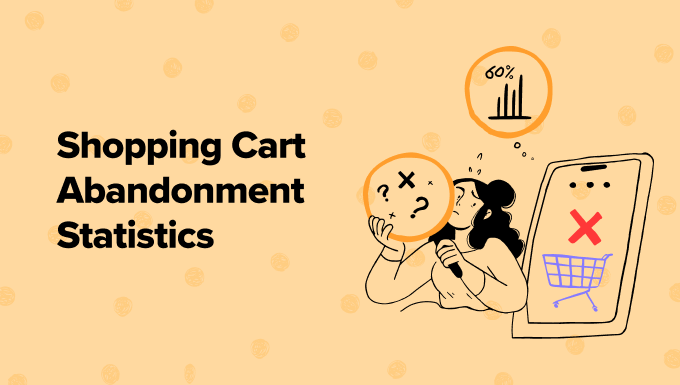Do you want to learn more about cart abandonment in the eCommerce industry?
Cart abandonment is one of the major problems that businesses face in the eCommerce sector. Companies lose billions of dollars each year when customers add items to their online carts but don’t complete their purchases.
There may be several causes for this problem. Some of them can be tied to customer behavior. Others are associated with the experiences offered by the company.
In this article, we have gathered a ton of shopping cart abandonment statistics to help you learn more about the issue, its causes, and prevention. The information can help you come up with reliable strategies to secure your sales by offering a seamless shopping experience to customers.

List of Shopping Cart Abandonment Statistics
To help you navigate this information easily, we have divided our online shopping cart abandonment statistics into different categories.
Just click the links below to jump to the section that interests you the most and view the different statistics:
eCommerce Statistics

- 56.6% of people prefer buying products online.
- The eCommerce growth rate is estimated to be 21.8% by 2024.
- The growth rate of mobile eCommerce is 29%.
- In retail, online sales are reported to exceed $7 trillion by the year 2025.
- People are expected to make 95% of their purchases online by 2040.
- 67.2% of online purchases are made via mobile devices.
- 9 out of 10 people explore reviews before making purchases online.
- 54.7% of people go through at least four reviews before completing a purchase.
- 97% of people want to know whether or not online stores respond to reviews.
- 49% of payments for online purchases are done through digital wallets like PayPal.
- 51% of people are likely to continue purchasing from an eCommerce business that offers live chat support.
- Amazon is the leading eCommerce app in the US, with a 37.8% market share.
- 43.8% of people exploring products don’t add them to their carts.
- 67% of millennials prefer buying products online.
- 56% of people representing Generation X prefer buying products online.
- 41% of baby boomers prefer buying products online.
- 28% of seniors prefer buying products online.
- 80% of younger people are likely to make impulsive buying decisions when shopping online.
- Only 2.86% of people visiting eCommerce websites end up completing a purchase.
Before we dive into shopping cart abandonment statistics, it’s best to know about the recent trends in the eCommerce industry.
The eCommerce industry is one of the fastest-growing sectors in the world. People are now more likely to buy things online than visit physical outlets to make purchases.
This change in customer behavior has caused rapid growth in online shopping. Because of this, a lot of aspiring entrepreneurs consider creating an online store when getting started.
Up to 80% of young people are likely to make impulsive buying decisions when shopping online. So, convincing them to buy from you is not that difficult. Just pair your marketing strategies with social proof and leverage the fear of missing out (FOMO).
Seeing a lot of people buy from your store and be happy with the purchase may inspire others to do the same.
To make it happen, we recommend using TrustPulse. This plugin allows you to display real-time social proof notifications that can inspire other users to become paying customers.
Showcasing high demand for a product can help you inspire others to complete their purchases and effectively counter cart abandonment.
That being said, the eCommerce industry has an alarming cart abandonment rate. The following statistics will help you become more familiar with the situation.
Shopping Cart Abandonment Rate Statistics

- The average shopping cart abandonment rate in 2023 was 70.19%.
- 2 out of 3 people are likely to abandon carts and not complete their purchases.
- eCommerce stores lose around $18 billion in revenue every year due to cart abandonment.
- The cost of abandoned products is estimated to reach $6.39 trillion by 2024.
- 60% of businesses are unable to discover their site’s cart abandonment rate.
- The cart abandonment rate reaches its highest from 6 p.m. to 9 p.m.
- People most likely to abandon carts fall in the age bracket of 25 to 44 years.
- 39% of retailers say that the cart abandonment rate is higher among women than men.
- The Caribbean region has a 92.18% cart abandonment rate.
- The Middle East has an 88.1% cart abandonment rate.
- The Arab States have an 87.88% cart abandonment rate.
- Africa has an 85.15% cart abandonment rate.
- Latin America has an 83.43% cart abandonment rate.
- Europe has a 79.28% cart abandonment rate.
- North America has a 79.14% cart abandonment rate.
- Asia-Pacific has a 76.32% cart abandonment rate.
- The cart abandonment rate in the travel industry is 87.08%.
- The cart abandonment rate in the fashion industry is 84.43%.
- The cart abandonment rate in the retail industry is 77.01%.
- The cart abandonment rate for utilities is 75.80%.
- 84% of people abandoning carts purchase online through mobile.
- 81.5% of iOS users abandon carts on their mobile devices.
- 81.3% of people using Android phones abandon their carts.
- 72% of people abandoning carts purchase online on desktop.
- The cart abandonment rate for Mac users is 71.9%.
- The cart abandonment rate for Windows users is 68.3%.
- The cart abandonment rate for different social media channels is 89.3%.
- The email cart abandonment rate is 80.6%.
- The cart abandonment rate for people who directly land on eCommerce sites is 78.9%.
- The cart abandonment rate for visitors referred to sites by search engines is 75.3%.
Shopping cart abandonment rate is an important metric for eCommerce businesses. It’s calculated by dividing the total number of completed purchases by the number of initiated sales (adds to cart).
eCommerce stores lose billions of dollars in sales revenue each year due to an increasing cart abandonment rate and must try their best to cope with the situation.
This is not as easy as it sounds. Many business owners struggle even to discover the number of people who did not complete their purchases from their stores.
Most people abandoning carts are adults, and the abandonment rate among women is higher compared to men.
Also, people living in the Caribbean region abandon their carts more frequently compared to other regions.
Cart abandonment is a burning issue in the travel sector, and the fashion industry is a close second.
People who shop through mobile devices are more likely to quit the checkout process midway compared to desktop. So, optimizing your website for mobile users may help you get more conversions.
Furthermore, people who find your website through social media are highly likely to abandon their carts compared to other marketing channels. Email is a close second here.
This shows that promoting your products through the right channel and to the right audience is very important to prevent cart abandonment.
To successfully reduce and recover cart abandonment, it’s best to know the reasons and create tailored strategies targeting the right demographic profile. We will discuss this in the next part of our statistics guide.
Shopping Cart Abandonment Reasons Statistics

- 60% of people abandon carts during the checkout process due to extra costs. Some examples of this include unexpected shipping costs and taxes.
- 58.6% of people abandon carts because they’re not ready to make a buying decision.
- 50% of online shoppers are likely to abandon carts because they’re dissatisfied with the delivery options.
- 37% of people abandon carts because they don’t want to create an account to complete the purchase.
- 34% of people abandon carts because they are just looking at products.
- 28% of people abandon carts due to a complex checkout process.
- 23% of people abandon carts because they can’t calculate the total order price upfront.
- 20% of people abandon carts due to poor website performance.
- 19% of people abandon carts due to lack of trust.
- 15% of people abandon carts because they can’t remember their account’s password.
Business owners often think that people abandon carts because they are not ready to purchase certain products. This may be one of the reasons that leads to cart abandonment. However, it’s not the only reason.
Seeing an extra amount added to the cart during checkout is a huge turn-off for most people. So, avoid adding any hidden costs.
Plus, showing your customers the breakdown of their total order cost may work wonders for you.
For example, with WPForms, you can allow your customers to calculate the total order price as per their specifications and not be surprised at the checkout.
Also, you have to remember that most people purchase online because it’s more convenient than visiting an outlet and buying from there. So, a long or complicated checkout process may lead to cart abandonment.
You could set up an express checkout button in WooCommerce so that users only have to click a single button to pay, instead of needing to fill out a long checkout form with their credit card information. Alternatively, there are many ways to optimize your checkout page.
Your website performance also comes into play here. Most people exit a website immediately if a page takes more than 3 seconds to load.
Furthermore, many people are super careful about sharing their information online. They find it difficult to trust new businesses. So, this may also be one of the factors leading to cart abandonment.
You can counter this by leveraging social proof to build trust.
For example, you can ask your customers to write testimonials and publish product reviews on your website to encourage new visitors to buy from you. You can even display testimonials from different sources like Google and Facebook using Smash Balloon Reviews Feed.
Shopping Cart Abandonment Prevention Statistics

- Offering a simple and fast online buying experience leads to 55% of people completing their purchases.
- 66% of people expect businesses to offer free shipping.
- 50% of businesses offering free shipping report a significant improvement in their sales.
- 40% of people will complete the purchase if the website offers multiple payment options.
- Having an easy return policy may lead 35% of people to complete their purchases online.
- An improved checkout process can lead to a 35% average conversion rate increase.
- 55% of people are likely to complete a purchase if a company has a quick and easy checkout process.
- The right prompt can inspire 87% of people who abandon their carts to complete their purchases.
- Exit-intent popups may help recover 53% of cart abandoning visitors.
- Predictive AI may lead to a drop in cart abandonment rates by 18%.
- eCommerce brands using automation to cope with cart abandonment report a 50% increase in conversions.
- Retargeting ad campaigns that inspire people to complete the purchase are likely to have an ROI (return on investment) of 1300%.
- The average open rate for cart abandonment emails is 39.07%.
- The average click rate for cart abandonment emails is 23.33%.
- The average conversion rate for cart abandonment recovery emails is 28.88%.
- 50% of people who click on cart abandonment emails are likely to complete their purchases.
- 40% of people who see personalized advertisements are likely to complete their purchases.
To prevent potential customers from abandoning their carts, you should explore the reasons and come up with tailored strategies.
You can reduce lost sales through two methods. First, you should consider being proactive and offering your customers a seamless shopping experience.
To offer a decent customer experience, the first thing you should do is improve your website’s performance.
You can use a free website speed test tool to see how quickly your pages load and optimize your online store’s performance to offer a better experience to your customers.
Furthermore, you should create a quick checkout process and make it easier for your customers to complete their purchases. This includes creating an optimized checkout flow, offering payment methods, providing a guest checkout option, and more.
Using exit intent may also come in handy here as well. This is when you show a targeted message to a user just before they leave your online store.
Sometimes, all you need is the right prompt to inspire a buying decision. If you look at the statistics, most people abandon carts and exit websites due to the additional amount added to their orders.
So, when they are trying to exit your site, you can offer users a discount coupon on the entire order and make them reconsider their decision. OptinMonster is a great plugin for this purpose, as it allows you to create high-converting exit intent popups and optins in just minutes.
Additionally, email marketing is one of the most effective and cost-effective ways to recover abandoned shopping carts. You can offer exclusive discounts or incentives via email to make your customers reconsider their decisions.
You can follow our guide on how to set up WooCommerce abandoned cart email campaigns for step by step instructions.
Overall, preventing cart abandonment may not be easy, but it’s not impossible to achieve. Sometimes, things as simple as free shipping or offering different payment options may work wonders for you.
Sources
OptinMonster, Hostinger, NotifyVisitors, Yaguara, Baymard Institute, BigCommerce, Statista, SaleCycle, FinancesOnline, AppicSoftwares, Moosend
We hope that our shopping cart abandonment statistics have helped you learn more about this problem and come up with new strategies for your eCommerce business. You may also want to see our tutorial on ways to recover abandoned cart sales for your online store and the best WooCommerce plugins for your store.





Syed Balkhi says
Hey WPBeginner readers,
Did you know you can win exciting prizes by commenting on WPBeginner?
Every month, our top blog commenters will win HUGE rewards, including premium WordPress plugin licenses and cash prizes.
You can get more details about the contest from here.
Start sharing your thoughts below to stand a chance to win!
Jiří Vaněk says
Thanks for collecting these statistics. I would be interesting to compare them before Covid pandemy. In our country during the Covid pandemy many people change theirs behavior about buying products. Many people switched theirs shopping habits to online world.